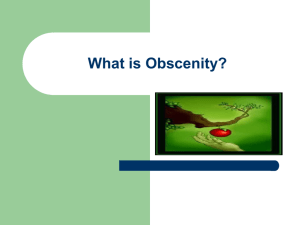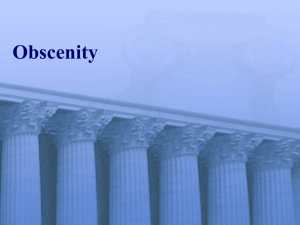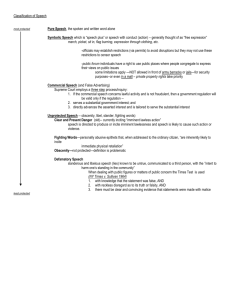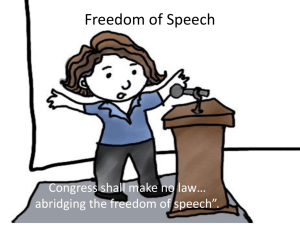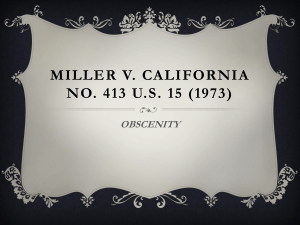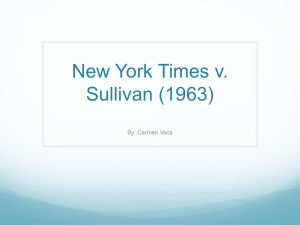Obscenity: An Outdated Concept for the Twenty-First Century Arnold H. Loewy*
advertisement
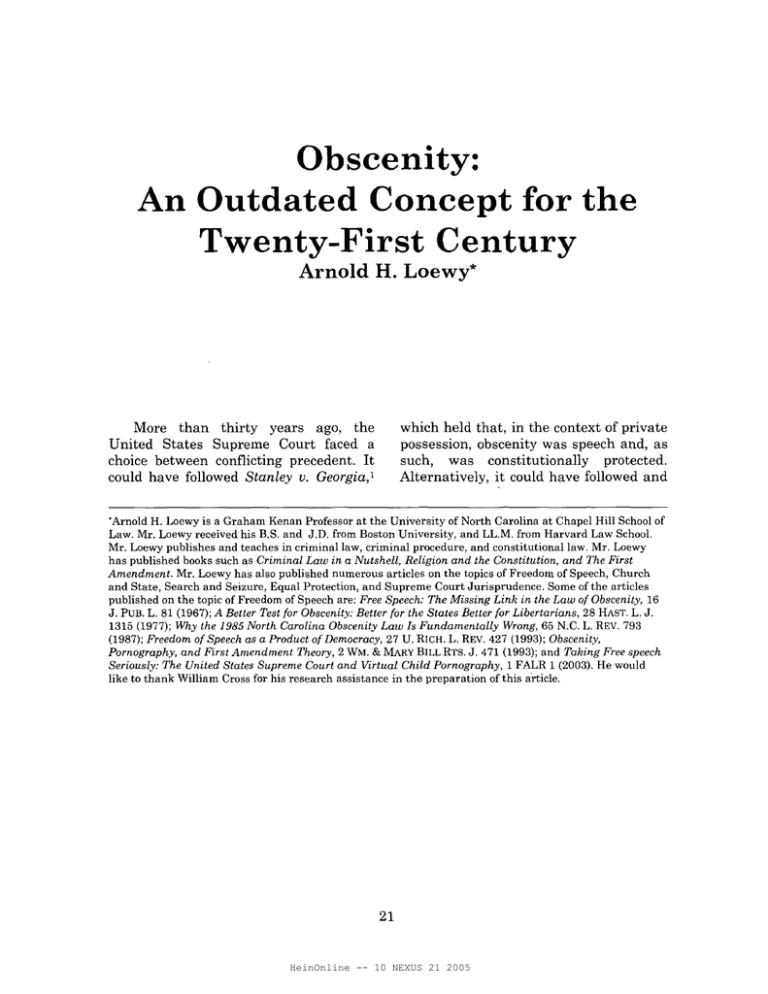
Obscenity:
An Outdated Concept for the
Twenty-First Century
Arnold H. Loewy*
More than thirty years ago, the
United States Supreme Court faced a
choice between conflicting precedent. It
could have followed Stanley v. Georgia, 1
which held that, in the context of private
possession, obscenity was speech and, as
such, was constitutionally protected.
Alternatively, it could have followed and
"Arnold H. Loewy is a Graham Kenan Professor at the University of North Carolina at Chapel Hill School of
Law. Mr. Loewy received his B.S. and J.D. from Boston University, and LL.M. from Harvard Law School.
Mr. Loewy publishes and teaches in criminal law, criminal procedure, and constitutional law. Mr. Loewy
has published books such as Criminal Law in a Nutshell, Religion and the Constitution, and The First
Amendment. Mr. Loewy has also published numerous articles on the topics of Freedom of Speech, Church
and State, Search and Seizure, Equal Protection, and Supreme Court Jurisprudence. Some of the articles
published on the topic of Freedom of Speech are: Free Speech: The Missing Link in the Law of Obscenity, 16
J. PUB. L. 81 (1967); A Better Test for Obscenity: Better for the States Better for Libertarians, 28 HAST. L. J.
1315 (1977); Why the 1985 North Carolina Obscenity Law Is Fundamentally Wrong, 65 N.C. L. REV. 793
(1987); Freedom of Speech as a Product of Democracy, 27 U. RICH. L. REV. 427 (1993); Obscenity,
Pornography, and First Amendment Theory, 2 WM. & MARy BILLRTS. J. 471 (1993); and Taking Free speech
Seriously: The United States Supreme Court and Virtual Child Pornography, 1 FALR 1 (2003). He would
like to thank William Cross for his research assistance in the preparation of this article.
21
HeinOnline -- 10 NEXUS 21 2005
NEXUS
expanded Roth v. United States,2 which
held that obscenity was not speech.
Unfortunately, in Miller v. California 3
and its companion cases, 4 the Court
opted for the latter, intentionally
expanding the category of material that
fell in the category of obscenity as
opposed to protected speech. 5
Notwithstanding Miller, the amount
of commercially available sexuallyexplicit entertainment has increased
exponentially.6
Little governmental
effort has been expended in the last
decade
to
halt
this
explosion. 7
Consequently, Miller has been reduced to
a decision that theoretically remains on
the books, but is less and less frequently
invoked. Instead, communities have
invoked various channeling devices
designed to protect themselves from
many of the perceived evils of obscenity,
such as exposure to children, unwanted
exposure to adults, and neighborhood
deterioration. 8
Despite this trend, the Justice
Department has recently announced
plans to prosecute for the dissemination
of
obscenity.9
The
Government's
rationale
appears
to
be
that,
notwithstanding the absence of any
exposure to children or unwilling adults
or the possible deterioration of any
neighborhood, the mere dissemination of
some films are so harmful to the
populace that they need to be
proscribed. 10
Should the Justice
Department prevail in this effort at the
trial level, the Supreme Court will have
another opportunity to consider whether
it should retain the concept of obscenity
as unprotected speech.
In the pages that follow, this essay
argues that the Court should take this
opportunity to travel the path not taken
in Miller and hold that there is no such
thing as obscenity. Instead, all speech is
protected. To the extent that sexuallyexplicit speech may sometimes cause
harm because of its manner of
dissemination, case law that has
developed since Miller is more than
adequate to deal with that harm.
Consequently, whatever utility Miller
once had in preventing social harms is no
longer present. Further, Miller has long
been antithetical to sound First
Amendment theory.ll
Therefore, it
should be overruled.
Roth
Although the Supreme Court had
previously hinted that there was a
category of speech called obscenity that
was not constitutionally protected,12 it
was not until Roth was decided in 1957
that the Court so held. 13 At various times
in the Roth opinion, the Court suggested
that obscenity was l).ot protected because
it was "utterly without redeeming social
importance,"14 non-ideological,15 "of such
slight social value,"16 "outweighed by the
social interest in order and moralitY,"17
and was intended to be unprotected by
the framers of the Constitution. 18
By holding that obscenity was not
speech, the Court was not compelled to
justify the anti-obscenity laws at issue.
Rather, it simply determined that
obscene material was constitutionally
unprotected.
Hence,
it could be
proscribed by legislative fiat. The fact
that the standards were somewhat
vague, thereby creating the possibility of
inconsistent verdicts, made no difference
to the Court because the First
Amendment was not implicated.l 9
The Court did attempt to define
obscenity
as
material
whose
predominant appeal is to the "prurient
interest," that is a shameful or morbid
interest in sex, and that the material
22
HeinOnline -- 10 NEXUS 22 2005
Arnold H. Loewy
goes substantially beyond customary
limits of candor in describing such
activity.20 Thus, presumably in all future
cases, juries must determine whether
these standards were met. 21 As Justice
Harlan stated in his partial dissent: "The
Court seems to assume that 'obscenity' is
a particular genus of 'speech and press,'
which is as distinct, recognizable, and
classifiable as poison ivy is among other
plants."22
Nearly a decade later, a decisive
plurality23 held in
Memoirs 24 that
obscenity required the coalescence of
three separate standards: First, the
material must predominantly appeal to
the prurient interest; second, the
material must be patently offensive to
contemporary community standards; and
third, the material must be utterly
without redeeming social importance. By
so holding, the Court retained the illconceived concept of obscenity, but at the
same time rendered it nearly impossible
to prove. 25 So, while the substance of
"obscenity is not speech" remained, the
number of potential convictions under
that
standard
was
dramatically
curtailed.
The Court conceded the truth of the
observation that "Roth does declare,
seemingly without qualification, that
obscenity is not protected by the First
Amendment."27 The Stanley Court noted
that "Roth and the cases following it
discerned an 'important interest' in the
regulation of commercial distribution of
obscene material."28 That could have
been the rationale of Roth, but it was
not. Rather, Roth was predicated on the
assumption that obscenity is not speech
and therefore the Government does not
have to explain its rationale for
punishing obscenity.
The disconnect between Roth and
Stanley does not stop there. Stanley
relied on a pre-Roth case,. Winters v. New
York,29 to hold that there is "a right to
receive information and ideas regardless
of their social worth,"30 a concept that
the Roth Court thought was inapplicable
to obscenity. Indeed, the Stanley Court
went so far as to restate the Winters
observation that: "The line between the
transmission of ideas
and
mere
entertainment is much too elusive for
this Court to draw, if indeed such a line
can be drawn at a11."31 As to "obscene"
entertainment, this analysis could not be
further from Roth.
Even more strikingly, the Stanley
Court rejected Georgia's interest in
protecting the mind of an individual from
the impure thoughts obscenity instills or
the improper conduct to which it may
lead. This, of course, is entirely
consistent with sound First Amendment
theory, but completely inconsistent with
Roth, which had allowed a conviction of a
person to stand for selling material
"which has a relation to sexual impurity
and has a tendency to excite lustful
thoughts."32
Thus, after Stanley, the Court was
faced with conflicting precedent: Roth,
Stanley
Just three years after Memoirs, the
Court decided Stanley v. Georgia,26 a
case that arguably cut Roth loose from
its moorings. Stanley involved a
prosecution for the private possession of
obscene materials. Because Roth had
held that obscenity was not speech,
Georgia argued that it could punish, mere
possession. Drugs, such as marijuana or
cocaine,
are
not
constitutionally
protected and their private possession
can be punished. So, asked Georgia, why
not obscenity?
23
HeinOnline -- 10 NEXUS 23 2005
NEXUS
which had held that obscenity is not
speech, and Stanley, which had held that
obscenity is speech with which the State
cannot interfere without an important
justification. The Court had two
directions in which it could go. It could
cabin or overrule Roth and rely on
Stanley, or it could cabin or overrule
Stanley and rely on Roth. In Miller v.
California 33 and its companion cases,34
the Court opted for the latter, severely
limiting Stanley while expanding Roth
far beyond the limitations previously
imposed by Memoirs. 35
to understand the type of sexual activity
she can purvey (definitely made clear
under Miller) as opposed to the obvious
vagueness of terms like "prurient,"39
"patently offensive," and "community
standards," which remain the law after
Miller.
Justice Brennan protested the
Court's decision on the ground that any
definition of obscenity was necessarily
overbroad or vague. That is, it could be
clear only by forbidding far more than
would be constitutionally justified.
Alternatively, any attempt to be nuanced
and prohibitive of only the worst sexually
explicit material would necessarily be
vague.
Unfortunately
for
Justice
Brennan, this epiphany came too late.
Earlier in his career, it was he, more
than any other Justice, who as one of the
authors of Roth and Memoirs, was
responsible for the obscenity doctrine in
its current form. 40
_ In Paris Adult Theatre v. Slaton,41 a
c~mpanion case to Miller, the Court for
the first time, thought it appropriate to
actually present justifications for antiobscenity laws. In addition to Justice
Brennan's concern in his dissenting
opinion for the well-being of juveniles
and non-consenting adults,42 the Court
referred to "the interest of the public in
the quality of life and the total
community environment, the tone of
commerce in the great city centers, and
possibly the public safety itself."43
Further elaborating on the point, the
Court, quoting Professor Bickel, opined:
"A man may be entitled to read an
obscene book in his room....We should
protect his privacy. But if he demands a
right to obtain the books and pictures in
the market, and to foregather in public
places-discreet if you will, but accessible
to all-with others who share his tastes,
then to grant him this right is to effect the
Miller
Miller not only fully resurrected
Roth, but also stripped it of the Memoirs
gloss. Specifically eschewing the idea
that material with a modicum of social
value cannot be obscene, the Court opted
for a three-part test consisting of
prurient appeal, patent offensiveness,
and the absence of serious literary,
artistic, political, or scientific value. 36 It
further held that prurience and patent
offensiveness were to be judged by
contemporary community standards, and
that, within certain broad limits,37 each
individual jury was to determine the
standards of its community.
Thus, perhaps even more clearly
than in Roth, the Court reaffirmed
Justice Harlan's fear that the Court sees
obscenity as a species of speech,
recognizable among other speech as
poison ivy is among plants. 3s In response
to Miller's vagueness argument, the
Court saw no problem because it
required the states to define precisely
what type of sexual activity could not be
portrayed in a patently offensive way. In
light of the opinion, one would think that
the Court believed that the vagueness of
obscenity lies in the purveyor's inability
24
HeinOnline -- 10 NEXUS 24 2005
Arnold H. Loewy
world about the rest of us, and to impinge
on other privacies."44
Perhaps, Miller and Paris Adult
Theater are most striking because of the
disconnect between the standards for
obscenity on the one hand and the
rationale for them on the other. Suppose,
for example, that the movie at Paris
Adult Theatre is tawdry, racy, and sexy,
but is not obscene, either because it has
some artistic or literary merit, or a jury
finds that it is just offensive, but not
patently offensive, or that its appeal is to
a tasteless, but not prurient, interest in
sex. The impact of the community values
detailed by the Court will be identical,
but depending on which side of an
ephemeral line the movie falls on, it will
either be fully protected speech or
obscenity outside the scope of any
constitutional protection.
The disconnect became a veritable
chasm in two of the other companion
cases, Orito 45 and 12 200-Ft. Reels of
Film. 46 In those cases, the Court held
that even private transportation of an
obscene film was not constitutionally
protected under Stanley. Although the
amount of material transported in these
cases may have suggested commercial
distribution,
the
decisions
were
predicated on the assumption that the
material was intended for private
(Stanley-protected) use. The Court
reasoned the theoretical possibility that
a child or unsuspecting adult could view
the obscenity once it gets outside the
home was enough to rationally justify
the Congressional enactment forbidding
the
transportation.
And,
because
obscenity is not speech, rationality was
all that was required.
Channeling Smut: A Closer
Means/End Fit
It is extremely doubtful that the
actual obscenity of a particular book or
movie makes any difference at all in
regard to our concern for community
environment, protecting children, or
protecting unwilling adults. If a
particular movie theater is showing a
sexually-explicit film that a jury has just
declared to be non-obscene, it is likely to
have very nearly the same deleterious
effects as last week's sexually-explicit
film which had been declared obscene.
Consequently, some jurisdictions have
attempted various channeling devices.
The prototype is most likely Young v.
American Mini-Theatres,47 which upheld
a zoning ordinance that required
sexually-explicit entertainment centers 48
to not locate in close proximity to one
another. The theory of the ordinance is
that non-obscene smut can create much
the same problem as obscene smut, and
consequently they should be dispersed so
as to minimize the potential harmful
effect on neighborhoods. The utility of
such an approach is that, when it works
well, it creates a win/win situation. The
City's quality of life concerns are
substantially met, while at the same
time the First Amendment rights of the
purveyors and viewers of the movies are
also substantially met. The City, of
course, does not get a total shutdown,
and the purveyors can not locate in their
favorite spot, but both sides are
substantially accommodated.
Of course, obscene material can still
be proscribed. But given that zoning
takes care of most of the harm, the added
cost of an obscenity prosecution may not
be worth the candle.
25
HeinOnline -- 10 NEXUS 25 2005
NEXUS
Today's Issues
include the voluntary adult consumers.
To the extent that this material has
actually been mailed, this argument will
fail. The Court has held, for good or ill,
that mailing obscene material allows the
entire
community
to
judge
its
obscenity.53
Material downloaded directly from
the Internet, however, is· a different
matter.
From
the
homeowner's
perspective, he is merely exercising his
Stanley rights. Plausibly the sender
could be liable under the reasoning of the
Orito case.54 However, a distinction could
be made between carrying something
outside the home and transmitting it
directly to the home. Stanley, after all, is
still good law. And it should mean more
than what Justice Black once feared:
"[I]n the future that case will be
recognized as good law only when a man
writes salacious books in his attic, prints
them in his basement, and reads them in
his living room."55
By way of analogy, other private
constitutional rights often carry with
them a corresponding public right as a
means of access. For example, the right
to use contraceptives, protected by
Griswold v. Connecticut, 56 includes the
right to have a reasonable opportunity to
obtain them. 57 Similarly, the right to an
abortion, perhaps the ultimate privacy
right, includes the right to have the
operation performed in a public facility
without unreasonable limitations.58
There is another factor militating
against allowing one to be prosecuted for
transmitting an obscene film over the
internet: the Supreme Court's recent
decision in Lawrence v. Texas. 59
Lawrence, among other things, held
that morality simpliciter could not justify
legislation. There must be some reason
for it other than morality. Given the lack
of public harm caused by a person
According to a recent CBS 60
Minutes investigation, more adults
watch sexually-explicit films than all
major sporting events combined. 49
Furthermore, practically every major
hotel chain offers in room sexuallyexplicit movies, which service is used by
a large portion of their clientele,
apparently to their immense profit.50
Even if some of these figures are
overstated,
it
is
apparent
that
pornography has become both big and
mainstream as a business. In such a
climate, does it make sense to prosecute
obscenity as such? Prior to the Ashcroft
attorney generalship, the answer seemed
to be generally "no."51
Now that a prosecution is again
being attempted,52 let us contemplate
what it might look like. Presumably the
defense attorney will regale the jury with
movies regularly shown in leading hotel
chains and offered by cable companies.
The prosecution will have to show that
the
material
distributed
by
the
defendants
is
substantially
more
prurient and more offensive than any of
those things. One can only imagine what
those arguments will be like. I can
imagine more than one juror wishing she
could take a Justice Black type approach
to the material (I won't watch it; it is all
protected).
And,
of
course,
the
prosecution will likely try to find the
most prudish people in the community to
sit on the jury, precisely the kind of
people who should not have to be
subjected to such a performance.
Then, there is the issue of
community. Because the material is
never in local stores or otherwise
commercially available in the city of
prosecution, the defendant will argue
that the relevant community should only
26
HeinOnline -- 10 NEXUS 26 2005
Arnold H. Loewy
interest. 62 Concluding that neither the
governmental interest in protecting
privacy, nor its interest in protecting
children qualified as applied to Extreme
Associates, the Court held the statute
unconstitutional as applied to Extreme
Associates. 63
Recognizing that predicating such a
conclusion on the First Amendment
would run afoul of Stanley's various
progeny, such as Orito, the Court,
instead, relied on the Due Process clause.
Concluding that the right to receive
obscenity was a fundamental due process
right of the consumer, the Court held
that a seller, who of course had standing
to raise the consumer's rights,64 could not
be prosecuted where it used care in
sending its material only to consenting
adults.
One would think that with such an
obvious end run around a whole line of
Supreme Court jurisprudence, the Third
Circuit would reverse and remand the
case for trial on the obscenity issue,
leaving the question initially in the
hands of the jury, and, depending on its
verdict, ultimately in the hands of the
Supreme Court. On the other hand, the
Supreme Court could grant certiorari
regardless of which way the Third
Circuit goes for the purpose of resolving
the potential conflict between Lawrence's
admonition that morality simpliciter can
not justify legislation, and all of the postStanley obscenity cases, which prohibited
the movement of obscenity in interstate
commerce, largely to protect morality. If
the Supreme Court does that, it clearly
should
invalidate
the
crime
of
transmitting obscenity via the internet,
and probably should also invalidate most
other transmitting crimes unless there is
a lot more evidence of potential exposure
to children, than anything that has
previously been seen. 65
watching obscenity downloaded at home,
Lawrence may well forbid conviction.
Conclusion
A lot has happened since the
Supreme Court decided that obscenity
was not speech. First, pornography has
become more mainstream. Second,
technology has advanced to the point
that obscenity can be disseminated in
private, where it is constitutionally
protected. Third, it is now sometimes
constitutionally permissible to channel
sexually-explicit material in a manner
that was not the case when Miller was
decided. And fourth, it is no longer
permissible to legislate on the basis of
morality.
In my view, the concept that
"obscenity is not speech" was never
sound constitutional doctrine. 60 It is
especially unsound now in light of these
cultural and legal changes. When and if
the Justice Department makes good on
its threat to prosecute for obscenity, it is
my fondest hope that the jury, as the
conscience of the community, returns a
verdict of not guilty. If it does not, the
United States Supreme Court will have
one more chance to decide the obscenity
question correctly. Perhaps they will get
it right this time.
Epilogue
Subsequent to writing this essay, the
Federal District Court for the Western
District of Pennsylvania decided the
Extreme Associates case discussed in this
essay.61 Relying heavily on Stanley and
Lawrence, the Court concluded that the
right to receive obscenity in the privacy
of one's home was a fundamental right
that could not be breached in the absence
of a narrowly-tailored statute designed to
meet
a
compelling
governmental
27
HeinOnline -- 10 NEXUS 27 2005
NEXUS
NOTES
APPEAL (Memphis), Feb. 9, 2002, at El. (reporting
that "the Bush Administration has vowed to
prosecute obscenity cases").
Some had also
speculated that the events of September 11, 2001
might deter this new emphasis on obscenity
prosecution.
However, in May 2002, Attorney
General John Ashcroft sent a memorandum to all
United States Attorneys in which he stated that
"the proliferation of obscenity, both via the Internet
as well as through more traditional channels, has
become a pervasive and destructive element in our
society. I am committed fully to dedicating the
resources necessary to combat this burgeoning
problem." Memorandum from John Ashcroft,
Attorney General, to "All United States Attorneys"
(May 7, 2002).
Cited in Clay Calvert, Adult
Entertainment and the First Amendment: a
Dialogue and Analysis with the Industry's Leading
Litigator and Appellate Advocate, 6 V AND. J. ENT.
L. & PRAC. 147 (Spring 2004).
8 See e.g., FCC v. Pacifica Foundation, 438
U.S. 726, 738 (1978) (upholding an FCC ruling that
required indecent broadcasts to be played only
during nighttime hours); City of Renton v. Playtime
Theatres, Inc., 475 U.S. 41, 54-55 (1986).
(Upholding a zoning restriction that precluded any
adult theatres from locating within 1,000 feet of a
residential neighborhood, church, park, or school)
Cr., Arnold H. Loewy, Obscenity, Pornography, and
First Amendment Theory, 2 WM. & MARy BILL RTS.
J. 471,485-493 (Winter 1993).
9 See United States v. Extreme Associates, No.
03-2303 (W.D.Pa. 2005).
10 See e.g. the statement of Mary Beth
Buchanan, U.S. Attorney for the Western District
of Pennsylvania that "We have just had a
proliferation of this type of material that has been
getting increasingly worse and worse. And that's
why it's important to enforce the law, and to show
the producers that there are limits. There are
limits to what they can sell and distribute
throughout the country."
Quoted in CBS 60
MINUTES supra note 6.
11 See Loewy, Obscenity, Pornography, and
First Amendment Theory, supra note 8.
12 See e.g. Chaplinsky v. New Hampshire, 315
U.S. 568, 571-72 (1942) ("There are certain
well-defined and narrowly limited classes of speech,
the prevention and punishment of which has never
been thought to raise any Constitutional problem.
These include the lewd and obscene."); Beauharnais
v. Illinois, 343 U.S. 250, 267 (1952) ("Certainly no
one would contend that obscene speech, for
1 Stanley v. Georgia, 394 U.S. 557 (1969).
2 Roth v. United States, 354 U.S. 476 (1957).
3 Miller v. California, 413 U.S. 15 (1973).
4 See Paris Adult Theatre I v. Slaton, 413 U.S.
49 (1973); United States v. Orito, 413 U.S. 139
(1973); Kaplan v. California, 413 U.S. 115 (1973);
and United States v. Twelve 200-Ft. Reels of Super
8 Mm. Film, 413 U.S. 123 (1973).
5 Miller, 413 U.S. at 24.
Briefly, Miller
rejected the Roth "national community" and "social
value" tests in favor of a new three-part test: (a)
whether
"the
average
person,
applying
contemporary community standards" would find
that the work, taken as a whole, appeals to the
prurient interest; (b) whether the work depicts or
describes, in a patently offensive way, sexual
conduct specifically defined by the applicable state
law; and (c) whether the work, taken as a whole,
lacks serious literary, artistic, political, or scientific
value. For a more complete discussion of the ways
in which Miller expanded the category of obscenity
see discussion post at nn 36-46; See also Marion D.
Hefner, "Roast Pigs" and Miller-Light: Variable
Obscenity in the Nineties, 1996 U. ILL. L. REV. 843,
848-853 (1996).
6 See Porn in the U.S.A, 60 MINUTES, (CBS
television broadcast, Sept. 5, 2003). Discussing the
ongoing rise of the pornography industry that has
grown into a $10 billion a year business.
Transcript available at http://www.cbsnews.coml
tories/2003/11121/60minutes/main585049.shtml
(last visited Oct. 8, 2004).
7 Several commentators have noted that the
Clinton Administration in general, and Attorney
General Janet Reno in particular, made it a policy
to limit obscenity prosecutions in order to focus the
Department of Justice's resources on other threats
that they judged to be more pressing or dangerous.
See e.g. Rachael Roemhildt, You Wouldn't Know It,
But Porn is lllegal, WASH. TIMES, Nov. 5, 1998, at
A2 (calling the Reagan-Bush era "the repressed
years" because of the peak in obscenity
prosecutions). See also DOJ Alert, Dec. 20, 1993, p.
6. (describing Reno's intention to "rein in the
authority" to prosecute obscenity). When the Bush
Administration and Attorney General John
Ashcroft came into office, many commentators
suggested that a new emphasis would be brought to
prosecuting obscenity. See e.g., Tom Walter, Porn
Gets Hardball, Kid-Glove Coverage, COMMERCIAL
28
HeinOnline -- 10 NEXUS 28 2005
Arnold H. Loewy
example, may be punished only upon a showing of
[clear and present danger]"); and Winters v. New
York, 333 U.S. 507, 515 (1948) ("When a legislative
body concludes that the mores of the community
call for an extension of the impermissible limits, an
enactment aimed at the evil [of obscenity) is plainly
within its power, if it does not transgress the
boundaries fixed by the Constitution for freedom of
expression.").
13 Roth, 354 U.S. at 492.
14 Id. at 484.
15 Id. at 485 (quoting Chaplinsky, supra note
12).
16Id.
17Id.
18 Id. at 483. ("At the time of the adoption of
the First Amendment, obscenity law was not as
fully developed as libel law, but there is sufficiently
contemporaneous evidence to show that obscenity,
too, was outside the protection intended for speech
and press.")
19 The Court has made it clear that where
First Amendment interests are implicated, the bar
for a statute to be found unconstitutional is set
much higher to avoid having a chilling effect on
protected speech. See e.g. Reno v. ACLU, 521 U.S.
844, 871-72 (1997) discussing how "the vagueness
of such a regulation raises special First
Amendment concerns because of its obvious chilling
effect on free speech."
20 See Roth, 354 U.S. at 488, note 20, adopting
the Model Penal Code's definition of obscenity (''We
perceive no significant difference between the
meaning of obscenity developed in the case law and
the definition of the A.L.I., Model Penal Code").
21 Notwithstanding that these newly minted
standards were not used in the cases before the
Court in which the convictions were affirmed. In
Roth, the trial judge instructed the jury that "the
words 'obscene, lewd and lascivious' as used in the
law, signify that form of immorality which has
relation to sexual impurity and has a tendency to
Id. at 486. In the
excite lustful thoughts."
companion case of Alberts v. California, 352 U.S.
962, on the other hand, the standard was "a
substantial tendency to deprave or corrupt its
readers by inciting lascivious thoughts or arousing
lustful desires." Id.
22 Id. at 497 (emphasis in original).
23 So described because the plurality Justices
represented the centrist votes on the Court.
24 A Book Named "John Cleland's Memoirs of
a Woman of Pleasure" v. Massachusetts, 383 U.S.
413 (1966).
25 Any lawyer worth his salt could establish
something socially-important in almost any book or
movie. See especially Justice Clark's critique of the
plurality opinion. Id. at 441-55.
26 Stanley, 394 U.S. at 557 (1969).
27 Id. at 560.
28 Id. at 563-64.
29 Winters v. New York, 333 U.S. 507 (1948).
30 Stanley, 394 U.S. at 563.
31 Id. at 566.
32 Roth, 354 U.S. at 486.
33 Miller, 413 U.S. 1 (1973).
34 See Slaton 413 U.S. 49 (1973), Orito, 413
U.S. 139 (1973), Kaplan, 413 U.S. 115 (1973) and
Twelve 200-ft. Reels of Super 8mm Film, 413 U.S.
123 (1973).
35 See supra text accompanying note 25.
36 Miller, 413 U.S. at 24.
37 See Jenkins v. Georgia, 418 U.S. 153, 154
(1974).
38 See supra text accompanying note 20.
Unsurprisingly, the Court did not refer to Justice
Harlan's analogy.
39 The Court defines prurient as shameful or
morbid, but CBS commentator, Steve Kroft, in
attempting to explain the term to the populace,
used "degrading." See CBS 60 Minutes special cited
supra note 6.
40 In an earlier article, I described him as a
little bit like a modern version of the legendary
Baron Von Frankenstein, who couldn't cage the
monster he had created. See Arnold H. Loewy,
Abortive Reasons and Obscene Standards, 52 N. C.
L. REV. 223, 240 (1973).
41 Slaton, 413 U.S. 49 (1973).
42 Id. at 106 ("[Recent Supreme Court
opinions have) reflected our emerging view that the
state interests in protecting children and in
protecting unconsenting adults may stand on a
different footing from the other asserted state
interests.").
43 Id. at 58.
44Id. at 59 (emphasis in original).
45 Orito, 413 U.S. 139 (1973).
46 Twelve 200-Ft. Reels of Film, 413 U.S. at
123 (1973).
47 Young v. American Mini-Theatres, 427 U.S.
50 (1976).
29
HeinOnline -- 10 NEXUS 29 2005
NEXUS
48 Adult entertainment centers often bring
together and offer for sale adult books and videos
as well as offering adult arcades and screens or
booths where adult films can be viewed.
49 See supra note 6. CBS 60 minute special
discussed in note 6. Specifically, 60 Minutes
reported that Americans spend more than $10
billion per year on adult entertainment, which is
more than they spend attending professional
sporting events, buying music or going out to see
mainstream movies.
50 See supra note 6 ("[T]he big hotel
chains...offer adult films on in-room pay-per-view
television systems. And they are purchased by ...
50 percent of their guests, accounting for nearly 70
percent of their in-room profits.").
51 See supra note 6, discussing the policy
choice made by Attorney General Janet Reno to
focus on more violent, harmful criminal activity.
52 See supra text accompanying note 7.
53 See e.g. Smith v. United States, 431 U. S.
291 (1977).
54 See supra discussion at text accompanying
note 46.
55 See United States v. Thirty Seven (37)
Photographs, 402 U.S. 363, 382 (1971) (Black, J.,
dissenting).
56 Griswold v. Connecticut, 381 U.S. 479
(1965).
57 See e.g. Carey v. Population Services Int'l,
431 U.S. 678 (1977).
58 See e.g. Doe v. Bolton, 410 U.S. 179 (1973).
59 Lawrence v. Texas, 539 U.S. 558 (2003).
60 See supra note 12.
61 United States v. Extreme Associates, 352 F.
Supp. 2d 578, (W.D.Pa. 2005).
62Id. at 586-87.
63Id.
64 See e.g. Carey v. Population Services 431
U.S. 678 (1977); Craig v. Boren, 429 U.S. 190
(1976); Griswold, 381 U.S. 479 (1965).
65 It is somewhat unfortunate that the
District Court chose to employ the compelling
government interest test because Lawrence did not
appear to require such a stringent test. 539 US at
579 (O'Connor, J., concurring). Since a rational
basis test (in which morality simpiciter cannot
count) would probably be sufficient to invalidate
laws precluding the discreet transmission of
obscenity, the District Court should not have
gratuitously waived a red flag in front of the
Supreme Court.
30
HeinOnline -- 10 NEXUS 30 2005
